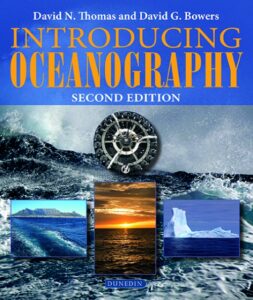Introducing Oceanography (2nd edition)
By David N Thomas and David G Bowers

The extent to which our planet is covered by oceans and seas (about 70%), and the increasing concern that right-minded people have about climate change, means that there is a both a desire and an urgent need to know more about and to encourage the development of ocean science. In fact, in recent years, this element of the earth sciences has dramatically improved our understanding of the important roles oceans play and how vital they are for regulating global climate. In addition, humans depend on the oceans for many resources, but, at the same time, their impacts on the marine systems around the world are increasingly of concern. Therefore, this is a timely and fascinating second edition to this little guide.
I reviewed the first edition of Introducing Oceanography back in 2012 (see Introducing Meteorology: A guide to weather; and Introducing Oceanography[LINK]) and I have to admit I enjoyed reading that addition to Dunedin’s ‘Introducing Earth and Environmental Sciences’ range of books. Anthony Kinahan (Director of Dunedin Academic Press) now tells me that this revised edition is:
Thoroughly revised, reorganised and expanded, the new edition … brings this well-established summary of oceanography up to date. One of the book’s strengths is the way in which it draws on many different branches of science together for those contemplating a course in oceanography, who may not have been taught the science in a holistic manner.”
That is certainly accurate in my view, regardless of your academic intentions (if any!). Like all the guides in the series, Introducing Oceanography has been written by leading scientists in their field. It also provides an overview of the science of the seas and oceans for students and, equally importantly, for interested adults (like me) wanting an easy to read guide to this enormous and complex subject.
The range of topics covered in the guide is extremely wide ranging, including coverage of the historical background to the water in the oceans, its density and density flows, ocean waves, tides, and stratification and fronts in shelf seas. It also covers other aspects of oceans that the reader might not initially think of, for example, the effect of light in the oceans, their biology and chemistry, primary production and ocean food webs, and biology at the ocean extremes. The book also contains a discussion of the way the oceans are changing, in particular, through climate change and finishes with a discussion of the methodology of ocean study.
Like all Dunedin guides, it is compact and copiously illustrated with colour photos and diagrams. The guide also contains a glossary of the more technical terms used (which are kept to a minimum) and a list of further reading for those who want to take the topic further.
Prof David N Thomas is Professor of Arctic Ecosystems Research at the University of Finland and David G Bowers, who has recently retired, worked with Prof Thomas when they were colleagues in the School of Ocean Sciences, at Bangor University in Wales.
Introducing Oceanography (2nd edition), by David N Thomas and David G Bowers, Dunedin Academic Press, Edinburgh (2021), 192 pages (paperback), ISBN: 9781780460956.